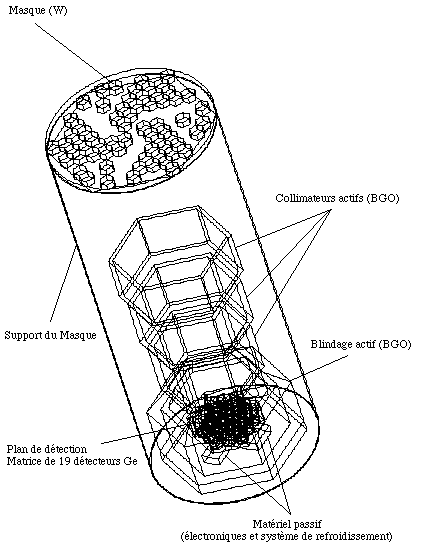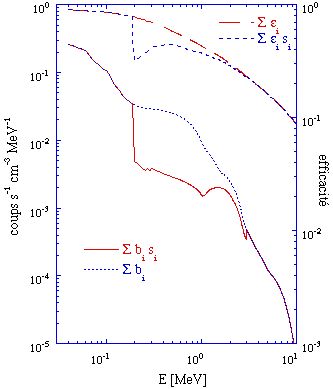
see also: - Jean et al., 1996, A&A Suppl.
Series, vol. 120, 4, p. 673
-Jean P., 1996, "Etudes et modélisation de spectromètres
gamma pour lĠastrophysique
nucléaire", Thèse de lĠUniversité Paul Sabatier, n°
dĠordre : 2564
-Jean et al., 1997, in "Proceedings of the second INTEGRAL workshop", ESA
publication
division, SP-382, p 635
Instrumental parameters (1997):
- Anticoincidence : BGO scintillator (size: 5.5
cm around the detectors; threshold: 80 keV)
- Plastic scintillator underneath the tungsten mask
- Period (2001-2003): solar maximum
Method:
Background-components and efficiency estimations have been done using
the GEANT code and empirical and semi-empirical cross-sections for the
calculation of the beta decay in Ge. The numerical model is shown in the
figure below.

View of the GEANT numerical model used for the calculation of the spectrometer performances (1997).

SPI background spectrum estimated for SPI (1997) presented by event-classes components. b1: single-detectors localized events (recognized by the PSD), b1: single-detectors non-localized events (recognized by the PSD), b3: multiple-detectors events without 511 keV signature (recognized by spectral analysis), b4: multiple-detectors events with 511 keV signature (recognized by spectral analysis).

Total SPI instrumental-background spectrum and peak-efficiency (1997) with and without reduction techniques - i.e. PSD (in order to reduce internal beta- decays background) and rejection of multiples events with a coincidence with an event at 511 keV in one detector (mostly induced by beta+ decay in Ge).

3-sigma narrow-line sensitivity of SPI for on-axis point sources. The
SPI-sensitivity is compared to others spectrometers for the same observation
time (1997).